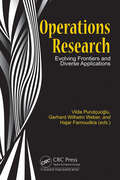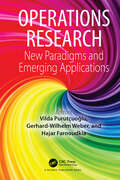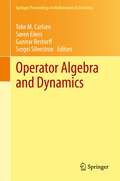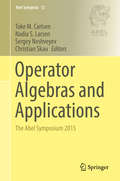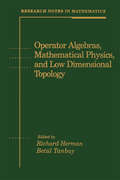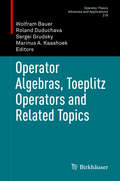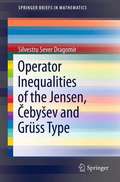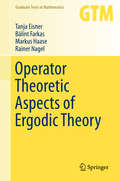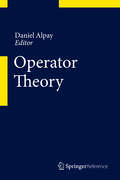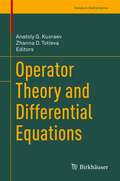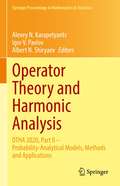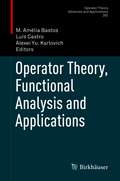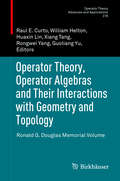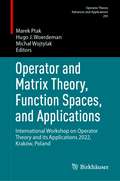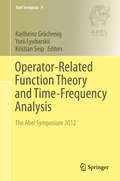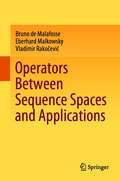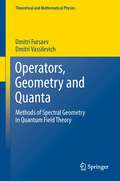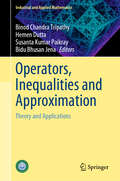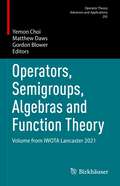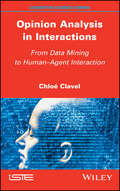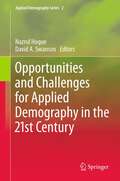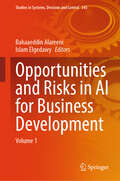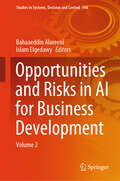- Table View
- List View
Operations Research: Evolving Frontiers and Diverse Applications
by Gerhard Wilhelm Weber Hajar Farnoudkia Vilda PurutçuoğluOperational research (OR) methods are used in many fields of sciences like computer engineering, industrial engineering, social works, business management, medical studies and finance. This book, is the second book in the series of Operational Research (OR) books. It brings together the latest advances of these methods written by experts from all over the world. The book comprises 13 chapters and is split into four main parts, i.e., OR in supply chain management, OR in production planning and inventory management, OR in signal processing and OR in social sciences. The book contains recent methodologies and comprehensive reviews where necessary, so that readers can follow up to date progress in the field while observing various applications with large datasets. The data used in the book is available in public databases. Therefore, the reader can easily access them and try their own approaches for comparison. Furthermore, since the book covers the literature reviews in each chapter, readers can both follow other benchmark techniques in the field and learn the theoretical aspects of the selected methods. In conclusion, the book will be assist in the discovery of new avenues for novel researchers who are interested in OR methods.
Operations Research: New Paradigms and Emerging Applications (International Series In Operations Research And Management Science Ser. #273)
by Gerhard-Wilhelm Weber Hajar Farnoudkia Vilda PurutçuoğluOperation Research methods are often used in every field of modern life like industry, economy and medicine. The authors have compiled of the latest advancements in these methods in this volume comprising some of what is considered the best collection of these new approaches. These can be counted as a direct shortcut to what you may search for. This book provides useful applications of the new developments in OR written by leading scientists from some international universities. Another volume about exciting applications of Operations Research is planned in the near future. We hope you enjoy and benefit from this series!
Operator Algebra and Dynamics
by Toke M. Carlsen Søren Eilers Gunnar Restorff Sergei SilvestrovBased on presentations given at the NordForsk Network Closing Conference "Operator Algebra and Dynamics," held in Gjáargarður, Faroe Islands, in May 2012, this book features high quality research contributions and review articles by researchers associated with the NordForsk network and leading experts that explore the fundamental role of operator algebras and dynamical systems in mathematics with possible applications to physics, engineering and computer science. It covers the following topics: von Neumann algebras arising from discrete measured groupoids, purely infinite Cuntz-Krieger algebras, filtered K-theory over finite topological spaces, C*-algebras associated to shift spaces (or subshifts), graph C*-algebras, irrational extended rotation algebras that are shown to be C*-alloys, free probability, renewal systems, the Grothendieck Theorem for jointly completely bounded bilinear forms on C*-algebras, Cuntz-Li algebras associated with the a-adic numbers, crossed products of injective endomorphisms (the so-called Stacey crossed products), the interplay between dynamical systems, operator algebras and wavelets on fractals, C*-completions of the Hecke algebra of a Hecke pair, semiprojective C*-algebras, and the topological dimension of type I C*-algebras. Operator Algebra and Dynamics will serve as a useful resource for a broad spectrum of researchers and students in mathematics, physics, and engineering.
Operator Algebras and Applications
by Toke M. Carlsen Nadia S. Larsen Sergey Neshveyev Christian SkauLike the first Abel Symposium, held in 2004, the Abel Symposium 2015 focused on operator algebras. It is interesting to see the remarkable advances that have been made in operator algebras over these years, which strikingly illustrate the vitality of the field. A total of 26 talks were given at the symposium on a variety of themes, all highlighting the richness of the subject. The field of operator algebras was created in the 1930s and was motivated by problems of quantum mechanics. It has subsequently developed well beyond its initial intended realm of applications and expanded into such diverse areas of mathematics as representation theory, dynamical systems, differential geometry, number theory and quantum algebra. One branch, known as "noncommutative geometry", has become a powerful tool for studying phenomena that are beyond the reach of classical analysis. This volume includes research papers that present new results, surveys that discuss the development of a specific line of research, and articles that offer a combination of survey and research. These contributions provide a multifaceted portrait of beautiful mathematics that both newcomers to the field of operator algebras and seasoned researchers alike will appreciate.
Operator Algebras, Mathematical Physics, and Low Dimensional Topology (Research Notes in Mathematics)
by Richard Herman Betiil TanbayThis volume records the proceedings of an international conference that explored recent developments and the interaction between mathematical theory and physical phenomena.
Operator Algebras, Toeplitz Operators and Related Topics: In Honor Of Nikolai Vasilevski (Operator Theory: Advances and Applications #279)
by Roland Duduchava Marinus A. Kaashoek Wolfram Bauer Sergei GrudskyThis book features a collection of up-to-date research papers that study various aspects of general operator algebra theory and concrete classes of operators, including a range of applications. Most of the papers included were presented at the International Workshop on Operator Algebras, Toeplitz Operators, and Related Topics, in Boca del Rio, Veracruz, Mexico, in November 2018. The conference, which was attended by more than 30 leading experts in the field, was held in celebration of Nikolai Vasilevski’s 70th birthday, and the contributions are dedicated to him.
Operator Analysis: Hilbert Space Methods in Complex Analysis (Cambridge Tracts in Mathematics #219)
by Jim Agler John Edward McCarthy Nicholas John YoungThis book shows how operator theory interacts with function theory in one and several variables. The authors develop the theory in detail, leading the reader to the cutting edge of contemporary research. It starts with a treatment of the theory of bounded holomorphic functions on the unit disc. Model theory and the network realization formula are used to solve Nevanlinna-Pick interpolation problems, and the same techniques are shown to work on the bidisc, the symmetrized bidisc, and other domains. The techniques are powerful enough to prove the Julia-Carathéodory theorem on the bidisc, Lempert's theorem on invariant metrics in convex domains, the Oka extension theorem, and to generalize Loewner's matrix monotonicity results to several variables. In Part II, the book gives an introduction to non-commutative function theory, and shows how model theory and the network realization formula can be used to understand functions of non-commuting matrices.
Operator Inequalities of the Jensen, Čebyšev and Grüss Type (SpringerBriefs in Mathematics)
by Silvestru Sever DragomirThe main aim of this book is to present recent results concerning inequalities of the Jensen, Čebyšev and Grüss type for continuous functions of bounded selfadjoint operators on complex Hilbert spaces. In the introductory chapter, the author portrays fundamental facts concerning bounded selfadjoint operators on complex Hilbert spaces. The generalized Schwarz's inequality for positive selfadjoint operators as well as some results for the spectrum of this class of operators are presented. This text introduces the reader to the fundamental results for polynomials in a linear operator, continuous functions of selfadjoint operators as well as the step functions of selfadjoint operators. The spectral decomposition for this class of operators, which play a central role in the rest of the book and its consequences are introduced. At the end of the chapter, some classical operator inequalities are presented as well. Recent new results that deal with different aspects of the famous Jensen operator inequality are explored through the second chapter. These include but are not limited to the operator version of the Dragomir-Ionescu inequality, the Slater type inequalities for operators and its inverses, Jensen's inequality for twice differentiable functions whose second derivatives satisfy some upper and lower bound conditions and Jensen's type inequalities for log-convex functions. Hermite-Hadamard's type inequalities for convex functions and the corresponding results for operator convex functions are also presented. The Čebyšev, (Chebyshev) inequality that compares the integral/discrete mean of the product with the product of the integral/discrete means is famous in the literature devoted to Mathematical Inequalities. The sister inequality due to Grüss which provides error bounds for the magnitude of the difference between the integral mean of the product and the product of the integral means has also attracted much interest since it has been discovered in 1935 with more than 200 papers published so far. The last part of the book is devoted to the operator versions of these famous results for continuous functions of selfadjoint operators on complex Hilbert spaces. Various particular cases of interest and related results are presented as well. This book is intended for use by both researchers in various fields of Linear Operator Theory and Mathematical Inequalities, domains which have grown exponentially in the last decade, as well as by postgraduate students and scientists applying inequalities in their specific areas.
Operator Theoretic Aspects of Ergodic Theory
by Tanja Eisner Bálint Farkas Markus Haase Rainer NagelStunning recent results by Host-Kra, Green-Tao, and others, highlight the timeliness of this systematic introduction to classical ergodic theory using the tools of operator theory. Assuming no prior exposure to ergodic theory, this book provides a modern foundation for introductory courses on ergodic theory, especially for students or researchers with an interest in functional analysis. While basic analytic notions and results are reviewed in several appendices, more advanced operator theoretic topics are developed in detail, even beyond their immediate connection with ergodic theory. As a consequence, the book is also suitable for advanced or special-topic courses on functional analysis with applications to ergodic theory. Topics include: * an intuitive introduction to ergodic theory * an introduction to the basic notions, constructions, and standard examples of topological dynamical systems * Koopman operators, Banach lattices, lattice and algebra homomorphisms, and the Gelfand-Naimark theorem * measure-preserving dynamical systems * von Neumann's Mean Ergodic Theorem and Birkhoff's Pointwise Ergodic Theorem * strongly and weakly mixing systems * an examination of notions of isomorphism for measure-preserving systems * Markov operators, and the related concept of a factor of a measure preserving system * compact groups and semigroups, and a powerful tool in their study, the Jacobs-de Leeuw-Glicksberg decomposition * an introduction to the spectral theory of dynamical systems, the theorems of Furstenberg and Weiss on multiple recurrence, and applications of dynamical systems to combinatorics (theorems of van der Waerden, Gallai,and Hindman, Furstenberg's Correspondence Principle, theorems of Roth and Furstenberg-Sárközy) Beyond its use in the classroom, Operator Theoretic Aspects of Ergodic Theory can serve as a valuable foundation for doing research at the intersection of ergodic theory and operator theory
Operator Theory
by Daniel AlpayA one-sentence definition of operator theory could be: The study of (linear) continuous operations between topological vector spaces, these being in general (but not exclusively) Fréchet, Banach, or Hilbert spaces (or their duals). Operator theory is thus a very wide field, with numerous facets, both applied and theoretical. There are deep connections with complex analysis, functional analysis, mathematical physics, and electrical engineering, to name a few. Fascinating new applications and directions regularly appear, such as operator spaces, free probability, and applications to Clifford analysis. In our choice of the sections, we tried to reflect this diversity. This is a dynamic ongoing project, and more sections are planned, to complete the picture. We hope you enjoy the reading, and profit from this endeavor.
Operator Theory and Differential Equations (Trends in Mathematics)
by Anatoly G. Kusraev Zhanna D. TotievaThis volume features selected papers from The Fifteenth International Conference on Order Analysis and Related Problems of Mathematical Modeling, which was held in Vladikavkaz, Russia, on 15 - 20th July 2019. Intended for mathematicians specializing in operator theory, functional spaces, differential equations or mathematical modeling, the book provides a state-of-the-art account of various fascinating areas of operator theory, ranging from various classes of operators (positive operators, convolution operators, backward shift operators, singular and fractional integral operators, partial differential operators) to important applications in differential equations, inverse problems, approximation theory, metric theory of surfaces, the Hubbard model, social stratification models, and viscid incompressible fluids.
Operator Theory and Harmonic Analysis: OTHA 2020, Part II – Probability-Analytical Models, Methods and Applications (Springer Proceedings in Mathematics & Statistics #358)
by Albert N. Shiryaev Alexey N. Karapetyants Igor V. PavlovThis is the second in the two-volume series originating from the 2020 activities within the international scientific conference "Modern Methods, Problems and Applications of Operator Theory and Harmonic Analysis" (OTHA), Southern Federal University, Rostov-on-Don, Russia. This volume focuses on mathematical methods and applications of probability and statistics in the context of general harmonic analysis and its numerous applications. The two volumes cover new trends and advances in several very important fields of mathematics, developed intensively over the last decade. The relevance of this topic is related to the study of complex multi-parameter objects required when considering operators and objects with variable parameters.
Operator Theory, Functional Analysis and Applications (Operator Theory: Advances and Applications #282)
by Alexei Yu. Karlovich M. Amélia Bastos Luís CastroThis book presents 30 articles on the topic areas discussed at the 30th “International Workshop on Operator Theory and its Applications”, held in Lisbon in July 2019. The contributions include both expository essays and original research papers reflecting recent advances in the traditional IWOTA areas and emerging adjacent fields, as well as the applications of Operator Theory and Functional Analysis. The topics range from C*–algebras and Banach *–algebras, Sturm-Liouville theory, integrable systems, dilation theory, frame theory, Toeplitz, Hankel, and singular integral operators, to questions from lattice, group and matrix theories, complex analysis, harmonic analysis, and function spaces. Given its scope, the book is chiefly intended for researchers and graduate students in the areas of Operator Theory, Functional Analysis, their applications and adjacent fields.
Operator Theory, Operator Algebras and Their Interactions with Geometry and Topology: Ronald G. Douglas Memorial Volume (Operator Theory: Advances and Applications #278)
by Guoliang Yu Raul E. Curto William Helton Huaxin Lin Xiang Tang Rongwei YangThis book is the proceeding of the International Workshop on Operator Theory and Applications (IWOTA) held in July 2018 in Shanghai, China. It consists of original papers, surveys and expository articles in the broad areas of operator theory, operator algebras and noncommutative topology. Its goal is to give graduate students and researchers a relatively comprehensive overview of the current status of research in the relevant fields. The book is also a special volume dedicated to the memory of Ronald G. Douglas who passed away on February 27, 2018 at the age of 79. Many of the contributors are Douglas’ students and past collaborators. Their articles attest and commemorate his life-long contribution and influence to these fields.
Operator and Matrix Theory, Function Spaces, and Applications: International Workshop on Operator Theory and its Applications 2022, Kraków, Poland (Operator Theory: Advances and Applications #295)
by Hugo J. Woerdeman Marek Ptak Michał WojtylakThis volume features presentations from the International Workshop on Operator Theory and its Applications that was held in Kraków, Poland, September 6-10, 2022. The volume reflects the wide interests of the participants and contains original research papers in the active areas of Operator Theory. These interests include weighted Hardy spaces, geometry of Banach spaces, dilations of the tetrablock contractions, Toeplitz and Hankel operators, symplectic Dirac operator, pseudodifferential and differential operators, singular integral operators, non-commutative probability, quasi multipliers, Hilbert transform, small rank perturbations, spectral constants, Banach-Lie groupoids, reproducing kernels, and the Kippenhahn curve. The volume includes contributions by a number of the world's leading experts and can therefore be used as an introduction to the currently active research areas in operator theory.
Operator-Adapted Wavelets, Fast Solvers, and Numerical Homogenization: From a Game Theoretic Approach to Numerical Approximation and Algorithm Design (Cambridge Monographs on Applied and Computational Mathematics #35)
by Houman Owhadi Clint ScovelAlthough numerical approximation and statistical inference are traditionally covered as entirely separate subjects, they are intimately connected through the common purpose of making estimations with partial information. This book explores these connections from a game and decision theoretic perspective, showing how they constitute a pathway to developing simple and general methods for solving fundamental problems in both areas. It illustrates these interplays by addressing problems related to numerical homogenization, operator adapted wavelets, fast solvers, and Gaussian processes. This perspective reveals much of their essential anatomy and greatly facilitates advances in these areas, thereby appearing to establish a general principle for guiding the process of scientific discovery. This book is designed for graduate students, researchers, and engineers in mathematics, applied mathematics, and computer science, and particularly researchers interested in drawing on and developing this interface between approximation, inference, and learning.
Operator-Related Function Theory and Time-Frequency Analysis
by Karlheinz Gröchenig Yurii Lyubarskii Kristian SeipThis book collects the proceedings of the 2012 Abel Symposium, held at the Norwegian Academy of Science and Letters, Oslo. The Symposium, and this book, are focused on two important fields of modern mathematical analysis: operator-related function theory and time-frequency analysis; and the profound interplay between them. Among the original contributions and overview lectures gathered here are a paper presenting multifractal analysis as a bridge between geometric measure theory and signal processing; local and global geometry of Prony systems and Fourier reconstruction of piecewise-smooth functions; Bernstein's problem on weighted polynomial approximation; singular distributions and symmetry of the spectrum; and many others. Offering a selection of the latest and most exciting results obtained by world-leading researchers, the book will benefit scientists working in Harmonic and Complex Analysis, Mathematical Physics and Signal Processing.
Operators Between Sequence Spaces and Applications
by Eberhard Malkowsky Vladimir Rakočević Bruno de MalafosseThis book presents modern methods in functional analysis and operator theory along with their applications in recent research. The book also deals with the solvability of infinite systems of linear equations in various sequence spaces. It uses the classical sequence spaces, generalized Cesaro and difference operators to obtain calculations and simplifications of complicated spaces involving these operators. In order to make it self-contained, comprehensive and of interest to a larger mathematical community, the authors have presented necessary concepts with results for advanced research topics. This book is intended for graduate and postgraduate students, teachers and researchers as a basis for further research, advanced lectures and seminars.
Operators, Geometry and Quanta
by Dmitri Fursaev Dmitri VassilevichThis book gives a detailed and self-contained introduction into the theory of spectral functions, with an emphasis on their applications to quantum field theory. All methods are illustrated with applications to specific physical problems from the forefront of current research, such as finite-temperature field theory, D-branes, quantum solitons and noncommutativity. In the first part of the book, necessary background information on differential geometry and quantization, including less standard material, is collected. The second part of the book contains a detailed description of main spectral functions and methods of their calculation. In the third part, the theory is applied to several examples (D-branes, quantum solitons, anomalies, noncommutativity). This book addresses advanced graduate students and researchers in mathematical physics with basic knowledge of quantum field theory and differential geometry. The aim is to prepare readers to use spectral functions in their own research, in particular in relation to heat kernels and zeta functions.
Operators, Inequalities and Approximation: Theory and Applications (Industrial and Applied Mathematics)
by Hemen Dutta Susanta Kumar Paikray Binod Chandra Tripathy Bidu Bhusan JenaThe book collects chapters on operator theory as well as related approximation results and analytic inequalities. It discusses the properties of various types of operators, methods for approximating such operators, proximity point problems, applications of approximation methods in other fields such as engineering, and some analytic inequalities. It seeks to capture both the pure and applied aspects of the topics discussed. Several of the concepts covered in the book are fundamental to many aspects of applied science and engineering. The intriguing and novel aspect of the book is that it focuses on foundational aspects of the topics as well as reasonable application ideas and inputs useful information for practical applications in a variety of other scientific and engineering fields.
Operators, Semigroups, Algebras and Function Theory: Volume from IWOTA Lancaster 2021 (Operator Theory: Advances and Applications #292)
by Gordon Blower Yemon Choi Matthew DawsThis volume collects contributions from participants in the IWOTA conference held virtually at Lancaster, UK, originally scheduled in 2020 but postponed to August 2021. It includes both survey articles and original research papers covering some of the main themes of the meeting.
Opinion Analysis in Interactions: From Data Mining to Human-Agent Interaction
by Chloe ClavelAs time goes on, big companies such as Amazon, Microsoft, Google and Apple become increasingly interested in virtual assistants. The interest and development of social robots has put research into affective and social computing at the forefront of the scene. The aim of Opinion Analysis in Interactions is to present methods based on artificial intelligence through a combination of machine learning models and symbolic approaches. Also discussed are natural language processing and affective computing, via the analysis and generation of socio-emotional signals. The book explores the analysis of opinions in human–human interaction and tackles the less-explored (yet crucial) challenges related to the analysis methods of user opinions within the context of human–agent interaction. It also illustrates the implementation of strategies for selecting and generating agent utterances in response to user opinions, and opens up perspectives on the agent’s multimodal generation of utterances that hold attitudes.
Opportunities and Challenges for Applied Demography in the 21st Century
by David A. Swanson Nazrul HoqueApplied demography continues its rapid pace of evolution in concert with the emerging trends of the 21st century. One significant area of change is the extension of applied demography beyond the United States; this book includes material dealing with applied demography in Australia, Canada, Estonia, and Mexico. Opportunities and Challenges for Applied Demography in the 21st Century presents a score of selected papers from the second post-2000 national conference on Applied Demography, held in San Antonio, Texas, in January, 2010, under the sponsorship of the Institute for Demographic and Socioeconomic Research at The University of Texas at San Antonio. Coverage includes the assembly of data by government agencies, with a focus on issues facing the United States; demographic issues associated with globalization; business demography and health demography, as well as a section examining methodological advances in the areas of estimation and projection.
Opportunities and Risks in AI for Business Development: Volume 1 (Studies in Systems, Decision and Control #545)
by Islam Elgedawy Bahaaeddin AlareeniThis book presents a groundbreaking exploration into the dynamic synergy between artificial intelligence and business development. Titled "AI Integration for Business Development: Navigating Opportunities, Unleashing Potential, Managing Risks," it serves as an indispensable guide for leaders and visionaries aiming to harness the transformative power of AI. The book introduces a comprehensive journey that unveils the strategic integration of AI into business development strategies. This book shows how to navigate a myriad of opportunities, strategically unleash untapped potential, and adeptly manage risks in the ever-evolving landscape of artificial intelligence. Through meticulous insights, real-world examples, and actionable strategies, readers gain the knowledge to make informed decisions and drive competitive advantage. This book presents not only a roadmap for identifying lucrative opportunities but also a blueprint for unlocking the full potential of AI technologies. Whether you are a seasoned executive, entrepreneur, or decision-maker, this book empowers you to proactively manage risks inherent in AI adoption, ensuring resilience and adaptability in your business model. Discover how to stay ahead in the rapidly changing business landscape, shaping the future of your business development initiatives. This book is your indispensable companion, offering profound insights into AI integration and empowering you to seize the transformative potential of AI. This book is your key to charting a course toward sustained success and innovation in the dynamic world of modern business.
Opportunities and Risks in AI for Business Development: Volume 2 (Studies in Systems, Decision and Control #546)
by Islam Elgedawy Bahaaeddin AlareeniThis book presents a groundbreaking exploration into the dynamic synergy between artificial intelligence and business development. Titled "AI Integration for Business Development: Navigating Opportunities, Unleashing Potential, Managing Risks," it serves as an indispensable guide for leaders and visionaries aiming to harness the transformative power of AI. The book introduces a comprehensive journey that unveils the strategic integration of AI into business development strategies. This book shows how to navigate a myriad of opportunities, strategically unleash untapped potential, and adeptly manage risks in the ever-evolving landscape of artificial intelligence. Through meticulous insights, real-world examples, and actionable strategies, readers gain the knowledge to make informed decisions and drive competitive advantage. This book presents not only a roadmap for identifying lucrative opportunities but also a blueprint for unlocking the full potential of AI technologies. Whether you are a seasoned executive, entrepreneur, or decision-maker, this book empowers you to proactively manage risks inherent in AI adoption, ensuring resilience and adaptability in your business model. Discover how to stay ahead in the rapidly changing business landscape, shaping the future of your business development initiatives. This book is your indispensable companion, offering profound insights into AI integration and empowering you to seize the transformative potential of AI. This book is your key to charting a course toward sustained success and innovation in the dynamic world of modern business.
